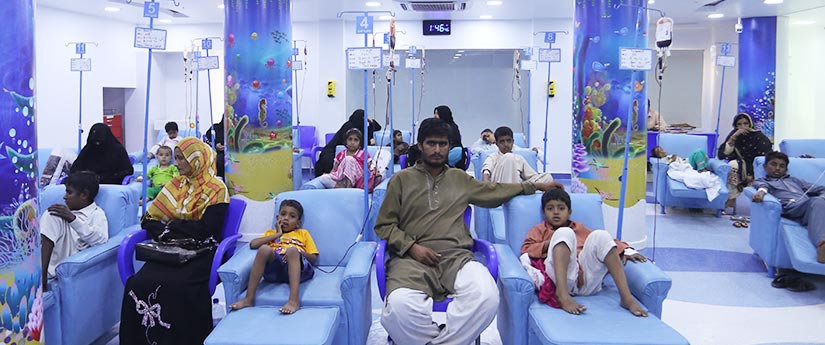
COMPLICATIONS
– ENDOCRINE
Patients with multi-transfused Thalassaemia Major (TM) develop severe endocrine complications. Iron overload due to multiple transfusions is the main cause of such complications hence proper and effective iron chelation therapy is essential for the reduction of iron deposition on various endocrine glands. Iron accumulates in tissues with high levels of transferrin-receptor such as liver, heart and endocrine glands.
– DIABETES
How should diabetes in thalassaemia be managed?
Ideally, with the best iron chelation therapy, iron overload diabetes will not occur in thalassaemia. This is the great future hope. However, worldwide diabetes is increasing so much that type 1 or 2 diabetes may occur in a person with thalassaemia. In thalassaemia, screening allows raised blood glucose levels to be detected at an early stage. At this stage of abnormal glucose tolerance, intensive iron chelation may prevent diabetes developing or can even revert blood glucose levels to normal. In addition, weight loss and exercise are both established ways to reduce insulin resistance and to prevent progression to diabetes.
Once diabetes develops, some oral anti diabetic drugs have been tested in thalassaemia. There are reports on the successful use of sulphonylureas and acarbose. Sulphonylureas (e.g. glibenclamide, gliclazide, glimepiride) lower blood glucose by increasing insulin release from pancreatic ß-cells. Acarbose inhibits the digestion of starch and sugars in the gut, reducing the rise in blood glucose after food. For type 2 diabetes, metformin is the first choice treatment but there is little research on its use in thalassaemia.
Metformin reduces insulin resistance and can protect against cardiovascular disease. It could be equally promising in thalassaemia and we certainly consider using metformin. For the many patients with thalassaemia who are insulin deficient, insulin is an essential daily treatment. Insulin must be injected (into the fat immediately below the skin). There are two main treatment regimens. The first uses biphasic insulins (e.g. NovoMix 30, Humalog Mix50) injected twice daily. These contain a mixture of rapidly acting and slower acting (intermediate) insulins, given before breakfast and before the evening meal.
– CONCLUSION
Managing diabetes is one of the greatest challenges that a person with thalassaemia can face. Training people to self-manage their diabetes and providing support from specialist teams working together are critical for excellent diabetes control. Only then will we see people with thalassaemia and diabetes achieving a long and healthy life.
TREATMENT
Iron chelation therapy is essential for patients with thalassaemia who are on transfusion programmes and also for those patients with thalassaemia intermedia who have developed iron overload either due to intermittent transfusions in the past or due to increased dietary iron absorption.
In all people, Iron moves from one area to another bound to a protein which makes it safe. In patients with thalassaemia this protein is rapidly fully loaded with iron leaving the harmful excess iron to move around in the blood freely. This free form of iron causes serious damage to how the major organs such as the liver and heart work. Some free iron can be stored safely and this is mainly in the liver and spleen, but once these are fully loaded, iron then will also start to load into the heart and endocrine organs (the glands that make hormones). The ferritin test generally reflects the storage form of iron. The free form of iron can only be measured in research labs.
There are two goals of iron chelation therapy; the primary goal of chelation therapy is to maintain safe levels of body iron and the secondary goal is to rescue patients who have developed toxic levels of iron resulting in organ damage. Unfortunately once iron overload has occurred the removal of excess iron is slow and may need several years of excellent compliance to treatment to completely clear the iron.
There are three drugs used for iron overload but in four regimes:
- Desferrioxamine (Desferal)
- Deferiprone (Ferriprox)
- Deferiprone and Desferrioxamine in combination
- Deferasirox (Exjade)
Life expectancy for younger thalassaemia patients is predicted to be even longer if current treatment guidelines are followed. It is important to recognize that as patients being aware of your blood results and what that means and good compliance with treatment is critical to a long life expectancy. Using chelation therapy as prescribed and with appropriate monitoring to help adjust treatment in a timely fashion is critical to ensuring that you live a long a healthy life. It is really important the critical tests such as MRI monitoring for hepatic and liver iron and blood tests such as glucose tolerance tests are done on a regular basis as many complications especially cardiac failure and diabetes can be avoided if there is timely changes in treatment. Remember it is your health and your life that is put at risk by missing these important tests and more importantly by missing treatment!
